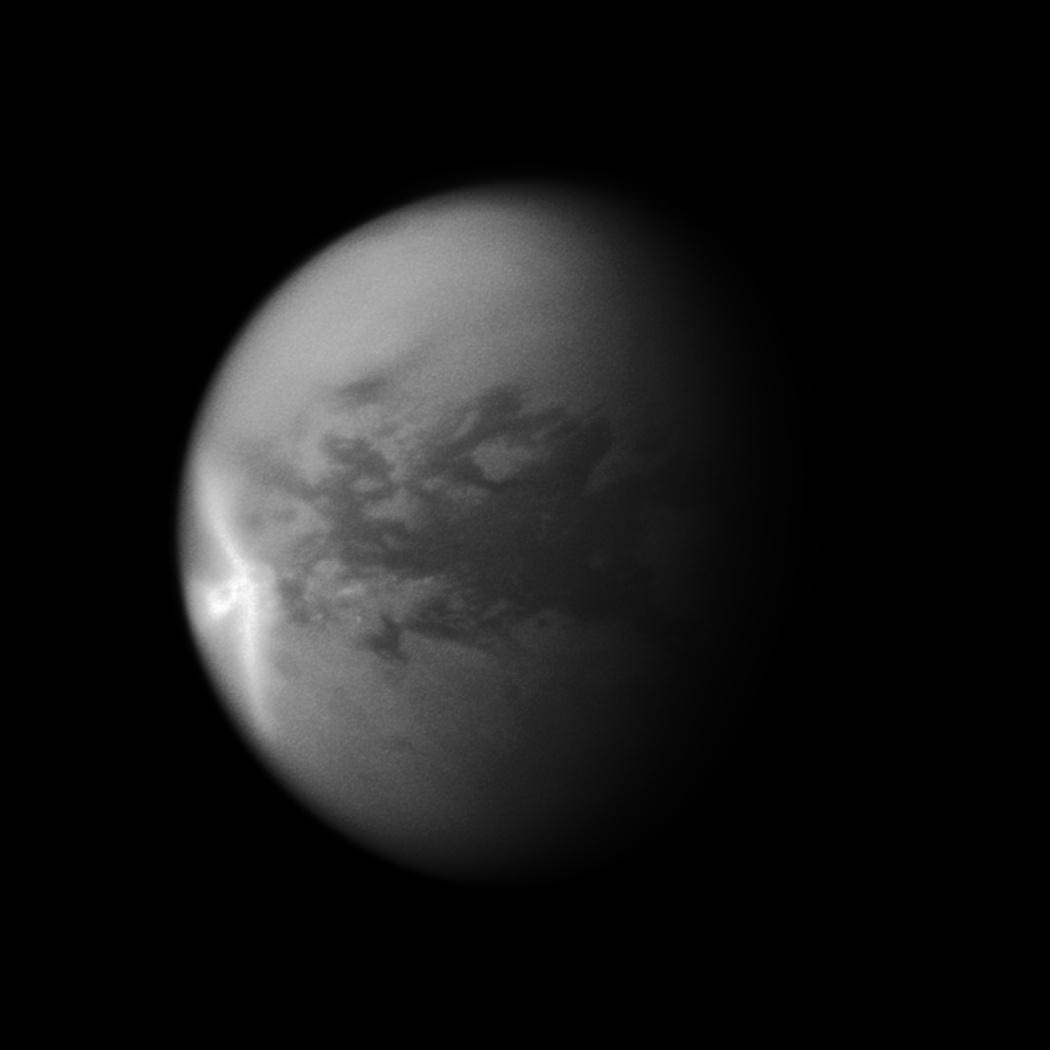[/caption]
Titan is making news again, this time with Cassini images from 2010 showing a storm nearly as big as Texas. Jonathan Mitchell from UCLA and his research team have published their findings which help answer the question:
What could cause such large storms to develop on a freezing cold world?
For starters, the huge arrow isn’t a cosmic detour sign reminding us to “Attempt No Landings” on Jupiter’s moon Europa.
In the study by Mitchell and his team, a model of Titan’s global weather was created to understand how atmospheric waves affect weather patterns on Titan. During their research, the team discovered a “stenciling” effect that creates distinct cloud shapes, such as the arrow-shaped cloud shown in the Cassini image above.
“These atmospheric waves are somewhat like the natural, resonant vibration of a wine glass,” Mitchell said. “Individual clouds might ‘ring the bell,’ so to speak, and once the ringing starts, the clouds have to respond to that vibration.”
Titan is the only other body in the solar system (aside from Earth) known to have an active “liquid cycle”. Much like Titan’s warmer cousin Earth, the small moon has an atmosphere primarily composed of Nitrogen. Interestingly enough Titan’s atmosphere is roughly the same mass as Earth’s and has about 1.5 times the surface pressure. At the extremely low temperatures on Titan, hydrocarbons such as methane appear in liquid form, rather than the gaseous form found on Earth.
With an active liquid both on the surface and in the atmosphere of Titan, clouds form and create rain. In the case of Titan, the rain on the plain is mainly methane. Water on Titan is rock-hard, due to temperatures hovering around -200 c.
Studies of Titan show evidence of liquid runoff, rivers and lakes, further emphasizing Titan’s parallels to Earth. Researchers believe better understanding of Titan may offer clues to understanding Earth’s early atmosphere. In another parallel to earth, the weather patterns on Titan created by the atmospheric waves can create intense rainstorms, sometimes with more than 20 times Titan’s average seasonal rainfall. These intense storms may cause erosion patterns that help form the rivers seen on Titan’s surface. Mitchell described Titan’s climate as “all-tropics”, basically comparing the weather to what is usually found near Earth’s equator. Could these storms be Titan’s equivalent of monsoon season?
Mitchell stated “Titan is like Earth’s strange sibling — the only other rocky body in the solar system that currently experiences rain”. Mitchell also added, “In future work, we plan to extend our analysis to other Titan observations and make predictions of what clouds might be observed during the upcoming season”.
The research was published Aug. 14 in the online edition of the journal Nature Geoscience .
If you’d like to learn more about the Cassini mission, visit: http://saturn.jpl.nasa.gov/index.cfm


What a strange, wonderful place. I long for a robotic lander on Titan’s surface.
William, there’s been talk of sending a robotic “boat” to Titan. I just hope we don’t name the ship after the moon it’s landing on. 😉
Personally I think it’d be a great candidate for a balloon “orbiter” like those ideas that were proposed for Mars: http://mars.jpl.nasa.gov/technology/balloons/
At the very least I think a better understanding of the surface of Titan should be gained before we send an expensive lander/rover.
Venus has a liquid cycle involving a rain of h2so4 that disassociates before reaching the surface, rises back up as a gas, then precipitates back down.
Yeah, I was gonna say! Maybe it only counts if it hits the ground 😉
Venus has a liquid cycle involving a rain of h2so4 that disassociates before reaching the surface, rises back up as a gas, then precipitates back down.
Didn’t I read somewhere recently that evidence of seasonal liquid water had been found on Mars too? Doesn’t that constitute a liquid cycle? Anyway, I agree with William Sparrow – Titan is an amazing place and would love a robotic lander.
The Europeans Landed on Titan.
Cassini–Huygens is a joint NASA/ESA/ASI spacecraft mission studying the planet Saturn and its many natural satellites since 2004. Launched in 1997 after nearly two decades of gestation, it includes a Saturn orbiter and an atmospheric probe/lander for the moon Titan, although it has also returned data on a wide variety of other things including the Heliosphere, Jupiter, and relativity tests. The Titan probe, Huygens, entered and landed on the moon in 2005. The current end of mission plan is a 2017 Saturn impact.
Source for the above paragraph: Wikipedia, from which it was copied verbatum. http://en.wikipedia.org/wiki/Cassini%E2%80%93Huygens
Source for the above paragraph: Wikipedia, from which it was copied verbatum. http://en.wikipedia.org/wiki/Cassini%E2%80%93Huygens
I was under the impression we had a probe on Titan…
WE?…if you mean isa, esa, and NASA you’re right…
We had a probe, yes – Huygens – that was dropped off by Cassini. It lasted a good 90 minutes.
I think they’re talking about getting something that’s more long term.
Yep, I was referring to something more along the lines of the Mars rovers, if possible. I’m familiar with Huygens, a great first step.
Yep, I was referring to something more along the lines of the Mars rovers, if possible. I’m familiar with Huygens, a great first step.
“Rain on the plain is mainly methane” — that was clever.